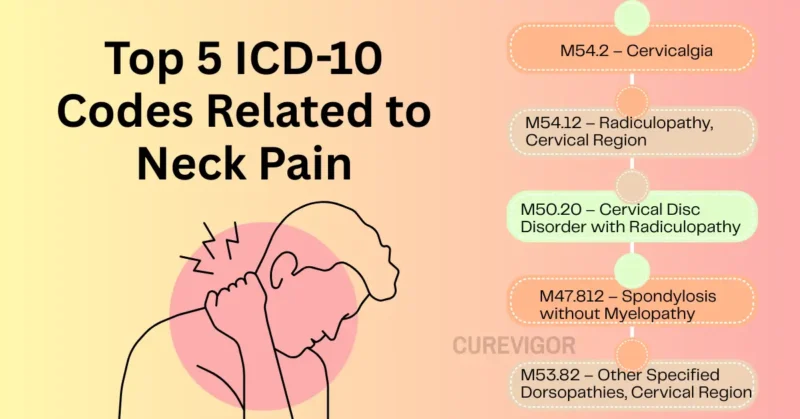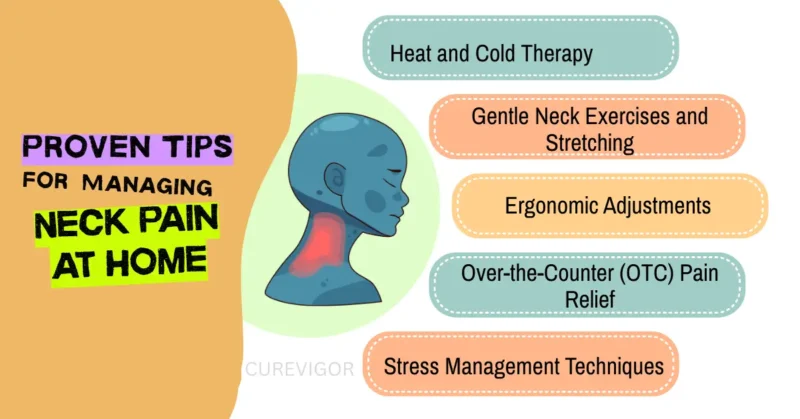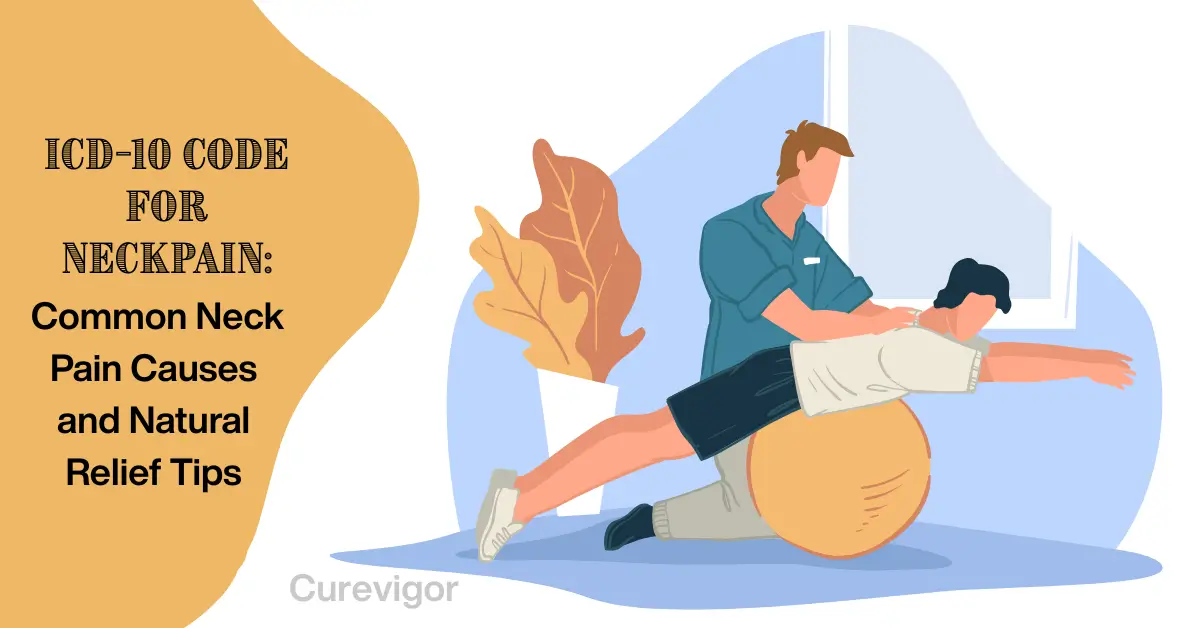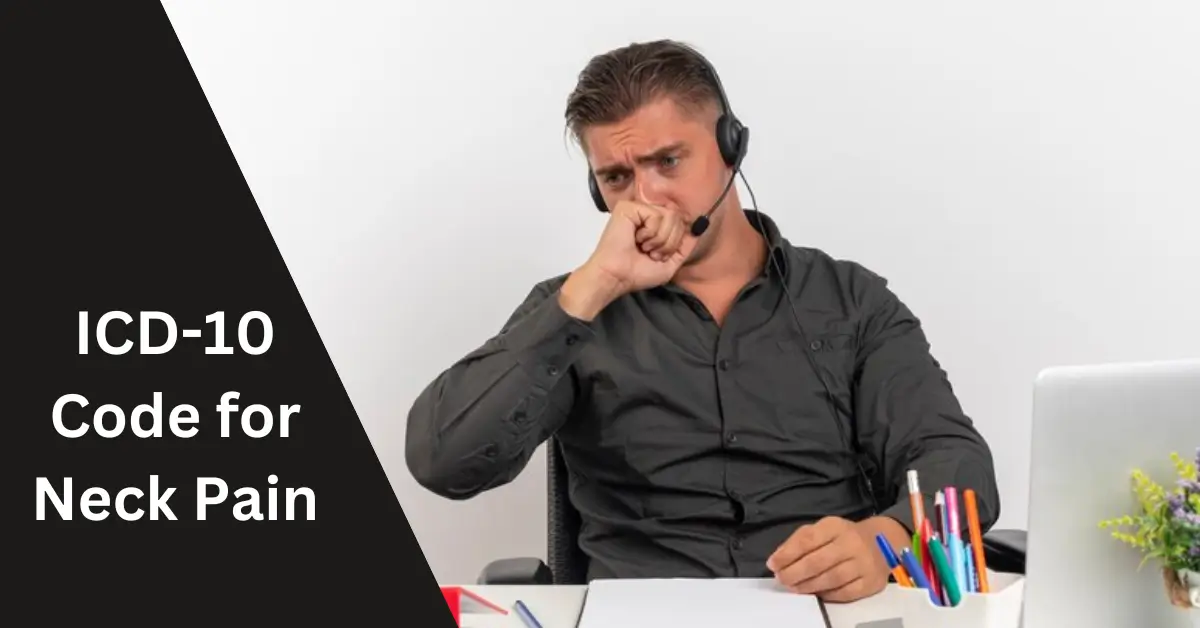Struggling with neck pain? Learn how to understand the ICD-10 code for neck pain, explore common causes of cervicalgia, and discover natural relief tips for lasting comfort.
Thank you for reading this post, don't forget to subscribe!Cervicalgia, commonly known as neck pain, is classified under the ICD-10 code M54.2. This condition is one of the most common complaints in modern healthcare, often associated with posture issues, muscle strain, or underlying medical conditions.
In this informative blog, you’ll learn what the code means, why it matters in medical records, and how it relates to the causes, symptoms, and treatment of neck pain.
The goal is to provide clear and practical insights that help both patients and professionals understand cervicalgia in a clear and useful way. If you have any queries about a medical problem, you should always see a trained healthcare expert.
Understanding the ICD-10 Code for Neck Pain

Are you suffering from neck pain? Cervicalgia (ICD-10 Code M54.2) is a common condition affecting millions. Uncover its causes, symptoms, treatment options, and expert tips on prevention and long-term relief.
Neck pain is a common ailment that affects millions worldwide. Accurate diagnosis and documentation are crucial for effective treatment and reimbursement. The ICD-10 coding system provides a comprehensive set of codes for various medical conditions, including neck pain.
This guide delves into the ICD-10 codes related to neck pain, ensuring precise and efficient coding.
Cervicalgia (M54.2) is a medical classification for localized neck pain affecting the cervical spine—the seven vertebrae supporting the head and upper body. Neck pain is a widespread issue, often linked to postural strain, nerve compression, or degenerative conditions.
The severity of cervicalgia varies from mild discomfort to intense, persistent pain that disrupts daily activities. Early diagnosis and treatment are crucial in preventing long-term complications such as chronic pain syndromes, nerve damage, or reduced mobility.
Why Is Cervicalgia So Common?
The cervical spine is flexible but vulnerable, making it prone to injuries and strain. Common causes of cervicalgia include:
- Poor ergonomics – Long screen time can cause “tech neck.”
- Sudden trauma – Accidents or whiplash may injure soft tissues.
- Muscle weakness – Weak neck muscles lead to poor posture and strain.
- Degenerative changes – Osteoarthritis or herniated discs often trigger chronic pain.
Without proper care, acute neck pain can become long-lasting, affecting sleep, work, and mental health.
Symptoms and Red Flags of Cervicalgia
Cervicalgia symptoms may develop gradually or suddenly, depending on the cause. Common signs include:
- Aching or stabbing neck pain, sometimes radiating to the shoulders or upper back
- Limited neck movement, especially when turning the head
- Muscle stiffness and tenderness
- Headaches linked to neck strain
- Tingling or numbness if nerves are affected
Red flag symptoms: Seek medical help immediately if you have sudden weakness, severe pain, dizziness, or difficulty swallowing. These may indicate a serious condition.
Importance of Accurate ICD-10 Coding
Accurate ICD-10 coding is vital for several reasons:
- Accurate use of ICD-10 codes is crucial because it helps:
- Improve patient care – Ensures correct diagnosis and treatment plans.
- Enable reimbursement – Correct coding allows smooth insurance claims.
- Support research – Provides reliable health data for studies and public health programs.
Top 5 ICD-10 Codes Related to Neck Pain

When doctors diagnose and document neck pain, they often use ICD-10 codes to classify the exact condition. These codes are important for medical records, billing, and treatment planning. Below are five of the most frequently used ICD-10 codes for neck pain, explained in simple terms.
1. M54.2 – Cervicalgia
This is the primary code for general neck pain. It applies when pain is localized to the cervical spine area without a more specific underlying diagnosis. Most people experiencing everyday stiffness, strain, or discomfort in the neck are recorded under M54.2.
2. M54.12 – Radiculopathy, Cervical Region
This code is used when neck pain is caused by nerve root compression. Symptoms often include sharp pain radiating into the shoulder, arm, or hand, sometimes with numbness or tingling. It’s commonly linked to herniated discs or bone spurs.
3. M50.20 – Cervical Disc Disorder with Radiculopathy
If a disc problem in the neck (such as degeneration or herniation) causes nerve irritation, doctors use this code to describe the condition. It helps distinguish disc-related neck pain from more general cervical spine pain. Patients often feel both localized neck discomfort and shooting pain down the arm.
4. M47.812 – Spondylosis without Myelopathy or Radiculopathy, Cervical Region
This code refers to age-related wear and tear of the cervical spine, also called cervical spondylosis. It’s one of the most common causes of chronic neck stiffness in older adults, but it does not involve nerve damage or spinal cord compression.
5. M53.82 – Other Specified Dorsopathies, Cervical Region
This is a broader “catch-all” code used when neck pain doesn’t fit neatly into other categories. It may include conditions like postural neck pain or muscle-related problems that aren’t caused by disc issues or arthritis.
Now, let’s discuss what you can expect when you visit a doctor for neck pain using everyday scenarios:
Why is M54.2 Important?
Think of M54.2 (Cervicalgia) as the “universal language” for neck pain:
- Accurate Communication: Imagine you’re in a foreign country and need help. If you can’t speak the local language, communication becomes a challenge. Similarly, in medicine, different healthcare providers need a common language to communicate your condition accurately.
So it helps doctors share the same understanding of your condition. M54.2 is like a precise translation of your neck pain, ensuring everyone understands what you’re experiencing. - Proper Diagnosis: Just as a mechanic needs to identify the exact issue in your car to fix it, a healthcare provider needs to diagnose your condition accurately. M54.2 tells them that your primary concern is neck pain.
This accurate diagnosis is crucial because it forms the foundation for developing the right treatment plan and identifies neck pain as the main issue, guiding treatment. - Tailored Treatment: Imagine you have a unique recipe, and each ingredient has a specific name. With the correct names, you can cook the dish perfectly. Similarly, M54.2 helps your healthcare provider tailor your treatment plan to address your neck pain effectively.
It guides them in choosing the right “ingredients”—medication, physical therapy, or other interventions. It ensures the right combination of therapy, medication, or interventions. - Insurance and Records: Just as you need a receipt for a purchase, healthcare providers need documentation. M54.2 acts as a receipt for your medical condition.
Insurance companies and healthcare facilities use it to keep track of your health history and ensure you receive the proper care. So it acts like a “receipt” for your medical history and care.
Finally, the ICD-10 code M54.2, representing cervicalgia or neck pain, is like the key to unlocking the door to effective diagnosis and treatment.
It ensures that healthcare professionals speak the same language regarding understanding and addressing your neck pain, ultimately leading to better care and a smoother journey toward relief.
What to Expect at the Doctor’s Office
When you visit a doctor for neck pain, here’s what usually happens:
Medical history
Your doctor asks when the pain started, what triggers it, and what relieves factors.
Like a detective gathering clues, your doctor will ask questions about neck pain. They’ll inquire about when it started, how it feels, and whether anything triggers or alleviates the pain.
This is like recounting the events leading up to a mystery; your doctor needs all the details to solve it.
Physical examination
They check neck mobility, tenderness, reflexes, and muscle strength.
Think of this as a thorough inspection of your car by a mechanic. Your doctor will check your neck’s range of motion, looking for stiffness or limitations.
They’ll press and prod to identify tender spots, just as a mechanic would inspect various parts for wear and tear. Additionally, your doctor may test your reflexes and muscle strength, similar to assessing the engine’s performance.
Diagnostic tests
Imaging such as X-rays, MRI, or CT scans may be ordered.
Sometimes, your doctor needs to take a closer look under the hood. Just as a mechanic might use diagnostic tools to identify issues, your healthcare provider may recommend X-rays, MRI, or CT scans to get a clearer picture of what’s happening inside your neck.
Diagnosis
The doctor identifies the root cause of your neck pain. Once all the evidence is gathered, your doctor plays the role of the detective, piecing together the puzzle.
They’ll provide a diagnosis, explaining what’s causing your neck pain. It’s like revealing the mystery’s solution – you finally know what’s causing discomfort.
Treatment plan
A personalized plan may include medication, physical therapy, or lifestyle changes. Your doctor then becomes your strategist, developing a personalized treatment plan.
This plan may include medications, physical therapy, exercises, or surgery.
It’s like a mechanic presenting you with a repair plan for your car, outlining the necessary steps to get it running smoothly again.
Treatment Options for Cervicalgia
Conservative Treatments
Most cases of neck pain can be managed with conservative treatments, including:
- Physical therapy – Strengthens muscles and improves posture.
- Medications – Pain relievers, muscle relaxants, and anti-inflammatories (under medical advice).
- Hot/Cold therapy – Reduces inflammation and stiffness.
- Lifestyle modifications – Ergonomic adjustments, exercise, and stress management.
Interventional Procedures
- Injections – Corticosteroid shots for inflammation.
- Radiofrequency ablation – Destroys pain signals from nerves.
- Spinal decompression – Relieves pressure on spinal nerves.
Surgical Options (for severe cases)
- Discectomy – Removes a damaged disc.
- Spinal fusion – Joins two vertebrae for support.
- Artificial disc replacement – Restores mobility with an implant.
5 Proven Tips for Managing Neck Pain at Home

Living with cervicalgia (ICD-10 Code M54.2) can make everyday activities uncomfortable, but small lifestyle changes can help reduce pain and support healing. Here are five practical, doctor-recommended strategies you can try at home:
Heat and Cold Therapy
- Start with a cold pack in the first 48 hours if the pain is sudden or due to strain. This reduces inflammation and numbs soreness.
- After that, switch to heat therapy — a warm compress, heating pad, or hot shower — to loosen stiff muscles and improve blood circulation.
- Alternating between heat and cold can also provide relief for chronic cervicalgia.
Gentle Neck Exercises and Stretching
- Slow, controlled stretches keep your neck muscles flexible. For example, tilt your head side to side, look over each shoulder, or gently roll your shoulders back.
- Regular stretching prevents stiffness that often worsens cervicalgia.
- Avoid fast or jerky movements, which can increase strain.
Ergonomic Adjustments
- Poor posture is one of the most common contributors to neck pain. Keep your computer screen at eye level, use a supportive chair, and avoid cradling your phone between your ear and shoulder.
- If you work at a desk for long hours, take short breaks every 30–45 minutes to stretch and move.
- Investing in ergonomic furniture can be a long-term solution for preventing neck discomfort.
Over-the-Counter (OTC) Pain Relief
- Non-prescription medications, like acetaminophen or ibuprofen, may provide short-term relief from cervicalgia symptoms.
- Topical gels or patches with menthol or lidocaine can also soothe aching muscles.
- Always follow dosage guidelines and consult your doctor before using this medication for an extended period.
Stress Management Techniques
Stress can cause your neck and shoulders to tighten, worsening cervicalgia. Mind-body practices such as mindfulness meditation, deep breathing, or progressive muscle relaxation can help release tension.
Activities like yoga and tai chi not only reduce stress but also strengthen muscles that support proper posture.
ICD-10 Codes for Common Cervical Spine Conditions
ICD-10 Code for Cervical Segmental Dysfunction
Cervical segmental dysfunction refers to impaired movement or alignment of the vertebrae in the neck region, which may lead to stiffness, discomfort, or reduced mobility.
This condition often arises from poor posture, repetitive strain, or muscle imbalance rather than a single identifiable injury.
It can affect the way nerves and muscles function in the cervical spine, sometimes contributing to tension headaches or localized pain.
In the ICD-10 classification system, cervical segmental dysfunction is commonly coded as M99.01 – Segmental and somatic dysfunction of the cervical region. This code is part of the M99 category, which includes dysfunctions of the spinal segments and related structures.
Healthcare professionals use this code to document clinical findings and to support treatment plans involving spinal therapy, physiotherapy, or manual care.
Understanding this code is important for both healthcare providers and patients who manage or research neck conditions. It ensures clear communication across medical records, insurance claims, and treatment plans, helping standardize how cervical dysfunction is reported and analyzed.
From a self-care perspective, while only licensed professionals can diagnose or treat such dysfunctions, maintaining good posture, regular stretching, gentle neck exercises, and ergonomic work habits can naturally support cervical health.
These preventive habits can help reduce stiffness and improve spinal alignment in daily life.
ICD-10 Code for Cervical Radiculopathy: Pinched Nerve in the Neck
In ICD-10, cervical radiculopathy is represented as M54.12, which stands for a pinched or compressed nerve in the neck. Radiating pain, tingling, or weakness in the hands, arms, or shoulders is a common symptom of this illness.
Poor posture, bone spurs, or herniated discs can all cause it to develop. Precise coding facilitates the monitoring of nerve-related neck disorders for data analysis and treatment.
ICD-10 Code for Cervical Facet Syndrome
Cervical facet syndrome, involving inflammation or irritation in the small joints of the cervical spine, is typically coded as M53.82 – Other specified dorsopathies, cervical region.
Patients may experience localized neck pain that worsens with prolonged sitting or movement. Maintaining appropriate posture and mobility can naturally support neck joint function, even if this problem can only be diagnosed by medical professionals.
Cervical Degenerative Disc Disease ICD-10 Code (M50.3)
Cervical degenerative disc disease is classified under M50.30 – Other cervical disc degeneration, unspecified cervical region. This condition describes the gradual wear and tear of the spinal discs in the neck, often linked to aging or repetitive stress.
It can cause stiffness, reduced flexibility, and sometimes nerve compression. Gentle stretching, ergonomic habits, and neck-strengthening exercises can help maintain comfort and mobility over time.
Comparison: Cervicalgia (M54.2) vs Cervical Segmental Dysfunction (M99.01)
| Feature | Cervicalgia (M54.2) | Cervical Segmental Dysfunction (M99.01) |
|---|---|---|
| Definition | Refers to general neck pain without specifying the cause. | Describes impaired movement or alignment in the cervical spine segments. |
| Primary Focus | Pain and discomfort in the neck region. | Dysfunction or restriction of vertebral motion and spinal mechanics. |
| Common Causes | Muscle strain, poor posture, injury, or stress. | Vertebral misalignment, repetitive strain, or postural imbalance. |
| Symptoms | Stiffness, soreness, radiating pain, and limited mobility. | Restricted motion, tension, localized discomfort, or nerve irritation. |
| ICD-10 Code Category | M54 – Dorsalgia (back and neck pain). | M99 – Biomechanical lesions and segmental dysfunctions. |
| Treatment Approaches | Rest, gentle stretching, heat therapy, and posture correction. | Chiropractic adjustments, physical therapy, posture training, and exercise-based rehabilitation. |
| Clinical Relevance | Used to classify and record cases of neck pain. | Used to identify biomechanical dysfunction in the cervical region for further evaluation. |
Key Insight
While both codes relate to neck conditions, M54.2 focuses mainly on pain symptoms, whereas M99.01 targets mechanical dysfunction in spinal movement.
Understanding the difference helps ensure accurate documentation, proper coding, and effective treatment planning across healthcare and wellness settings.
Preventing Cervicalgia: Smart Habits for Everyday Life

Preventing neck pain is often easier than treating it. Incorporating these habits into your daily routine can reduce your risk of developing cervicalgia (ICD-10 Code M54.2) in the future:
- Practice Good Posture: Keep your head aligned with your spine while standing and sitting. Avoid slouching or leaning forward for long periods.
- Take Frequent Breaks: If you spend hours at a computer or on your phone, take a moment to stretch and move.
- Stretch Daily: Gentle neck and shoulder stretches keep your muscles flexible and improve circulation.
- Choose Supportive Sleep Essentials: A firm, supportive pillow and a good mattress maintain spinal alignment through the night.
- Stay Active: Walking, yoga, and swimming are examples of low-impact activities that increase flexibility and fortify the supporting muscles.
When you combine home remedies with healthy daily practices, you can effectively manage cervicalgia and prevent recurring neck pain.
FAQs on ICD-10 Code
Q. What is the correct ICD-10 code for neck pain?
The correct ICD-10 code for neck pain is M54.2, also known as Cervicalgia. This code is used when a patient reports general pain in the cervical spine region without a more specific underlying diagnosis. Cervicalgia can result from poor posture, muscle strain, or prolonged periods of sitting at a desk.
Doctors use this code frequently in medical records and billing. It helps classify the condition for both clinical and insurance purposes. If additional symptoms, such as nerve involvement, are present, other ICD-10 codes may be applicable. M54.2 remains the standard for uncomplicated neck pain.
Q. What are common neck pain treatments?
The underlying cause of neck discomfort determines how it is treated; however, conservative measures are frequently used first. Stiffness and edema are frequently reduced by heat or cold therapy.
Over-the-counter medications, such as ibuprofen or acetaminophen, can provide temporary relief. Gentle stretching and posture correction exercises are highly recommended to ease muscle strain.
Ergonomic adjustments at work or home play a big role in preventing recurring pain. Stress management, yoga, and relaxation techniques also help reduce tension. In cases that are persistent or severe, doctors may recommend physical therapy or further medical evaluation.
Q. How to diagnose the cause of neck pain?
A complete medical history and physical examination are the first steps in determining the cause of neck pain. Doctors will ask about lifestyle habits, posture, recent injuries, and the nature of the pain.
They check for muscle tightness, range of motion, and nerve involvement. For a more thorough analysis of the bones, discs, and nerves, imaging procedures including MRIs, CT scans, and X-rays may be prescribed. Sometimes, nerve conduction studies are used to assess electrical activity in the muscles.
Blood tests may also rule out infections or inflammatory conditions. A proper diagnosis ensures the right treatment plan is created for long-term relief.
Q. What is the ICD-10 code for other disorders of the neck?
“Other Specified Disorders of the Neck” has the ICD-10 code M53.82. When a patient has neck issues that do not fall under one of the more popular categories, such as spondylosis or cervicalgia, this code is used.
Examples may include postural issues, muscle-related discomfort, or less typical structural changes. It acts as a flexible classification when the exact cause of neck pain isn’t easily defined.
Using this code enables doctors to accurately record and track cases that fall outside standard diagnoses. It ensures that symptoms are recognized and addressed in medical records. M53.82 is helpful for both clinical clarity and insurance documentation.
The Bottom Line on ICD-10 Codes
Understanding ICD-10 codes is vital for anyone involved in healthcare documentation, billing, or research. Whether it’s cervical segmental dysfunction (M99.01), a pinched nerve in the neck (M54.12), cervical facet syndrome (M53.82), or degenerative disc disease (M50.3), each code precisely identifies and manages cervical spine conditions, improving communication between providers and insurers.
Even if you’re not a medical professional, understanding ICD-10 codes gives you clearer insight into your health reports. Combined with healthy habits, this knowledge empowers you to make informed decisions about neck and spinal care.
Takeaway: Don’t ignore neck pain. Accurate diagnosis and early care can make all the difference in recovery and long-term health. Take care of your neck health and stay informed — learn more about ICD-10 codes to understand your medical reports better and make smarter wellness choices every day.
Note: This article is for informational purposes only and does not provide medical advice, diagnosis, or treatment. Always seek the guidance of a qualified healthcare professional with any questions you may have regarding a medical condition.
If you found this guide helpful, share it with others.
Read more practical Health and Wellness Tips.
You might like to read:

